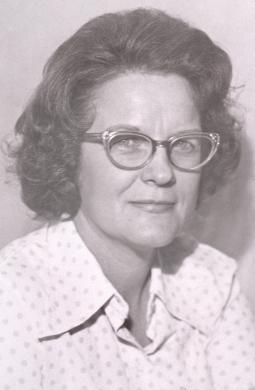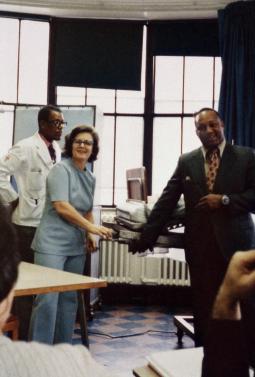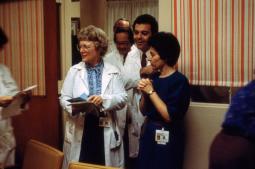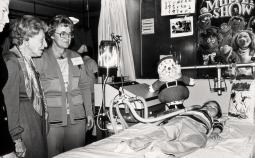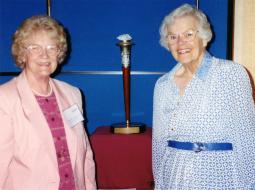Polio Place
A service of Post-Polio Health International
Augusta Strongman Alba, MD
Born: October 7, 1924
Major Contribution:
Dr. Alba’s medical career, ultimately as Associate Professor of Rehabilitation Medicine at New York University, centered on polio survivors who required breathing assistance. Her dedication to solving the respiratory insufficiency problems of polio patients led her to master every piece of ventilator equipment and technique—the rocking bed, chest cuirass, frog breathing and noninvasive ventilation. She realized that polio survivors could be healthier and live more independently if they were provided assistance with breathing and coughing. The Cof-flator (O.E.M. Corporation, East Norwalk, Connecticut) was an early device she used with patients and when the manufacturer stopped making it, she and an associate, Dr. John Bach, worked diligently until they found a new manufacturer, the J. H. Emerson Company (bought by Respironics which was bought by Philips.)
Other Information:
Brief Bio: Augusta Strongman Alba grew up on a farm in Highland, New York, and was one of five siblings. She graduated from Cornell University Medical School in New York in 1951, one of only eight women in a class of 100. After taking two years leave of absence for family responsibilities, she became an intern at Brooklyn Hospital, followed by two years at the Veterans’ Administration Hospital in New York, with residencies in both Neurology and Psychiatry. In 1957, she completed her fellowship in Physical Medicine and Rehabilitation at New York University Medical School.
From 1957 through 1997, Dr. Alba practiced medicine at the Coler-Goldwater Specialty Hospital and Nursing Facility. In the early days she was instrumental in establishing the Goldwater Memorial Hospital National Foundation for Poliomyelitis Regional Respiratory Center, which closed following the successful eradication of polio in America. In the ‘80s and ‘90s, she was the premier consultant on the care of post-polio syndrome for people with significant respiratory issues.
Her 53-year career is a testament to her dedication to polio patients. She witnessed the replacement of the iron lung - once the most common way polio survivors with severely compromised respiratory systems were kept alive - with a range of smaller, more portable devises that are used noninvasively.
She held numerous positions and titles there, from clinical instructor to Director of Respiratory Rehabilitation Center. She is affiliated with New York University Medical Center/Rush Institute of Physical Medicine and Rehabilitation, Long Island University and the New York University College of Dentistry. She was appointed to the Panel of Physicians for the New Jersey Crippled Children’s Commission, Independent Living for the Handicapped in Brooklyn, New York, and Wheelchair Charities, Inc.
Her memberships include the American Academy of Physical Medicine and Rehabilitation and New York Society of Physical Medicine and Rehabilitation. Her numerous awards include Humanitarian of the Year Award from Concepts of Independence, Inc.; award of Appreciation from The Rehabilitation Medicine Association of the Republic of China and from the New York City Independent Living Center; Woman of the Year of the Woman’s Advisory Committee, Health and Hospital Corporation; and the Humanitarian Award from the Smithtown Parkinson Therapy Center of Smithtown, Long Island.
Dr. Alba always sought to educate both her colleagues and polio survivors about the importance of appropriate equipment and personal assistance. In addition to co-authoring many seminal medical articles on the respiratory topic, her lectures and publications reflect a life-long body of work focused on assisting the respiratory-disabled patient to live the most independent life possible.
Post-Polio Health International honored Augusta “Gussie” Alba, MD, along with Jacquelin Perry, MD, at its 8th (2000) International Post-Polio and Independent Living Conference held in St. Louis, Missouri, for their years of freely giving medical and practical advice to survivors of polio.
In 1944, Dr. Alba married Louis Alba whose professions included chemical engineering, chiropractic practices, and a radiology business. He was interested in airplanes and built his own. The couple has 8 children. Norma, their fifth child, once said, “We all knew Mom was the scholastic one. Dad had common sense. We learned early on not to encourage her to cook.”
Description of Publications: See “Major Articles” tab.
Location of Publications: See NYU Health Sciences Library.
GLOSSARY
CHEST SHELL - a fiberglass shell fitted across the chest. To assist inhalation, negative pressure is created outside the chest wall when air is sucked from the shell through tubing attached to a ventilator.
GPB - glossopharyngeal breathing or "frog breathing" is a method of obtaining more air by gulping air into the lungs using the tongue and throat muscles.
INTERMITTENT POSITIVE PRESSURE VENTILATION (IPPV) - air is delivered into the lungs at a controlled amount of pressure or volume, either via mouth (with lip seal or mouthpiece to suck air from), via nose (with nasal or face mask), or via tracheostomy.
LIP SEAL - mouthpiece strapped to head to prevent air from leaking from the mouth.
PNEUMOBELT - a corset-type affair worn around the abdomen to assist expiration. It intermittently inflates, compressing the abdomen, and forcing air out of the lungs. Effective only when sitting or standing.
PONCHO - fabric garment, similar to body wrap, attached by tubing to ventilator. Same negative pressure principle as chest shell. Effective only in supine position.
VITAL CAPACITY - the maximum amount of air that can be exhaled after taking a deep breath.
November 2012/Carol K. Elliott & Joan L. Headley/Post-Polio Health International
Major Articles: Augusta Strongman Alba, MD
Sleep and Nocturnal Mouthpiece IPPV Efficiency in Post-Poliomyelitis Ventilator Users. Bach, J.R., Alba, A.S. CHEST Journal, 1994: 106(6):1705-1710.
Airway Secretion Clearance by Mechanical Exsufflation for Post-Poliomyelitis Ventilator-Assisted Individuals. Bach, J.R., Smith, W.H., Michaels, J., Saporito, L., Alba, A.S., Dayal , R., Pan, J. Archives of Physical Medicine & Rehabilitation, 1993: 74(2):170-177.
The Ventilator-Assisted Individual. Cost Analysis of Institutionalization vs. Rehabilitation and In-Home Management. Bach, J.R., Intintola, P. Alba, A.S., Holland, I.E. CHEST Journal ,1992: 101(1): 26-30.
Pulmonary Dysfunction and Sleep Disordered Breathing as Post-Polio Sequelae: Evaluation and Management. Bach J.R., Alba, A.S. Orthopedics, 1991: 14(12): 1329-1337.
Non-invasive Options for Ventilatory Support of the Traumatic High Level Quadriplegic Patient. Bach, J.R., Alba, A.S. CHEST Journal, 1990: 98(3):613-619.
Management Alternatives for Post-Polio Respiratory Insufficiency. Assisted Ventilation by Nasal or Oral-Nasal Interface. Bach, J.R., Alba, A.S., Shin, D. American Journal of Physical Medicine & Rehabilitation, 1989: 68(6):264-271.
Pneumobelt for Sleep in the Ventilator User: Clinical Experience. Yang, G.F., Alba, A., Lee, M., Khan, A. Archives of Physical Medicine & Rehabilitation, 1989: 70(9):707-711.
Glossopharyngeal Breathing and Noninvasive Aids in the Management of Post-Polio Respiratory Insufficiency. Bach, J.R., Alba, A.S., Bodofsky, E., Curran, F.J., Schultheiss, M. Birth defects original articles series, Warm Springs, GA, ed, March of Dimes, 1987:23(4):99-113.
Mouth Intermittent Positive Pressure Ventilation in the Management of Post-polio Respiratory Insufficiency. Bach, J.R., Alba, A.S., Bohatiuk, G., Saporito, L., Lee, M. CHEST Journal, 1987: 91(6):859-864.
Community Living for Ventilator-Dependent Individuals: A Quarter-Century Overview. Lee, M.H.M., Kahn, A., Alba, A., Rusk, H.A. Today's therapeutic trends, 1985: 2(4):31-40.
Discharge Planning Protocol for the Severely Disabled Ventilator Dependent Patient. Tuths, C.A., Lee, M.H.M., Alba, A.S. Archives of Physical Medicine & Rehabilitation, 1984: 65(10):631-631.
Long-Term Respiratory Rehabilitation in the Treatment of Neuromuscular Disease. Bach, J., Alba, A., Lee, M.H.M., Rideau, Y. Annales de readaptation et de medecine physique, 1983:26:101-109.
Independent Living of the Severely Disabled Patient. Lee, M.H., Zaretsky, H.H., Nolan, A.M., Alba, A. Archives of Physical Medicine & Rehabilitation, 1983:64(10):501-501.
Physiological Parameters Which Limit Duration of Glossopharyngeal Breathing. Pilkington, L.A., Alba, A., Schultheiss, M., Puma, F., Lee., M. Federation Proceedings (Federation of American Societies for Experimental Biology) 1975:34(3):427-427.
